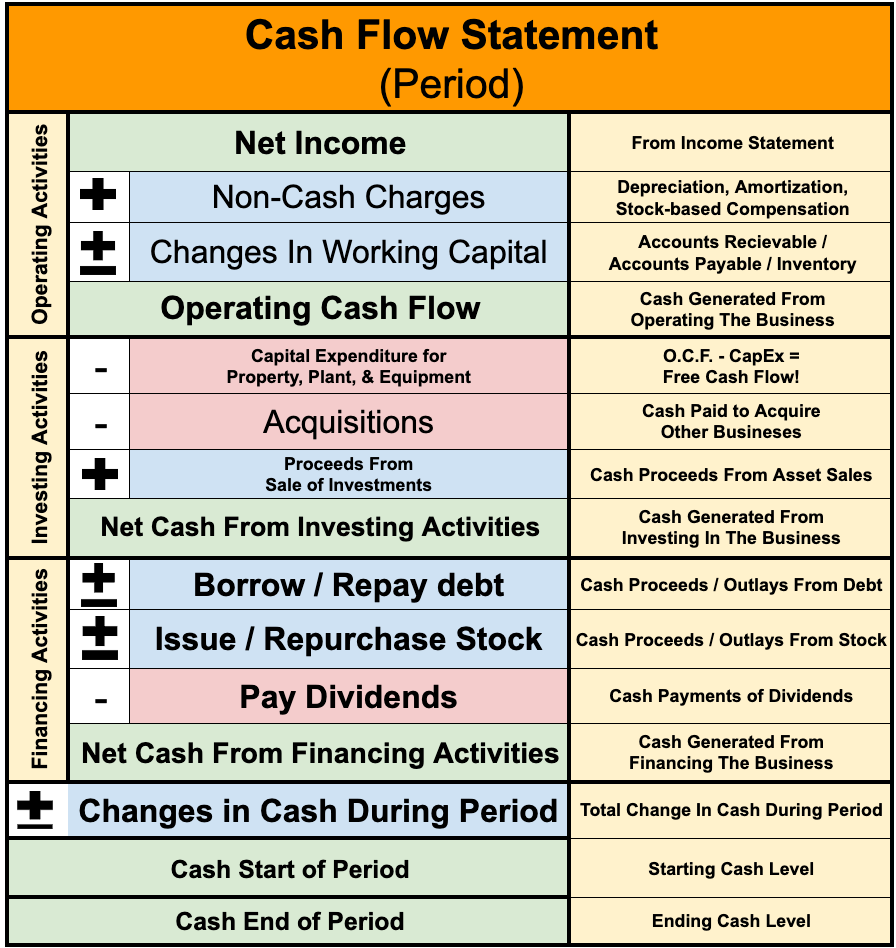Cash Flow Statement Yellow Flags
KEY POINTS
Why use a Cash Flow Statement?
The Cash Flow Statement is one of the three financial statements investors must understand to analyze businesses.
The purpose of the cash flow statement statement is to track cash movement. It shows how cash moves through a company over a period of time, such as a quarter or year.
A company’s cash flow statement can be compared to your personal checking account. It doesn’t care about transactions of goods and services being sold or when sales contracts are signed. It only tracks when money is deposited or withdrawn from a company’s bank accounts.
It uses cash accounting, not accrual accounting, making it unique from income statements and balance sheets.
Here are eight yellow flags you can easily identify when looking at a cash flow statement.
- Net Income Negative Starting at the top of the cash flow statement, when net income is negative, it indicates the company is not generating a profit from its sales. While a business might be able to continue to operate by using the cash on its balance sheet, issuing more shares, or borrowing money, none of those are good long-term options.
- Stock-Based Compensation More Than 10% of Net Income Stock-based compensation is a way companies can reward employees without paying more in salary. The benefits are that it aligns employees with the company’s goals. It can be especially helpful for young, growing companies that might not yet generate much free cash flow. The downside is that it dilutes the ownership stake of existing shareholders. When stock-based compensation reaches 10% of net income, investors need to recognize that management is seriously diluting them!
- Operating Cash Flow Lower Than Net Income Operating cash flow is probably the most important number on the cash flow statement. Operating cash flow adds back non-cash charges like depreciation, amortization, and stock-based compensation. It should always be larger than net income. When this number is significantly lower than net income, it can signal certain troubling signs, such as unsold inventory.
- Free Cash Flow Lower Than Net Income Free cash flow represents how much cash the business generated during the period. It’s a great sign when free cash flow is more significant than net income. Conversely, when free cash flow lags, it could signal that the business needs to invest a lot in capital expenditures to keep up with the competition. Pro tip: Determine if capital expenditures are being used to expand or maintain existing property and equipment. If it’s being used to maintain existing physical assets, that is much more troubling than using it on smart growth projects.
- Capital Expenditures More Than 25% of Net Income Few great companies need to reinvest significant profits into the business to grow. It’s a great sign when capital expenditures are consistently less than 25% of net income.
- Debt Increasing Great companies do not need to rely on debt markets to fund themselves, especially in an environment of high interest rates. Look for companies reducing their debt load, not increasing it.
- Stock Offering Stock issuance is negative. Like stock-based compensation, it dilutes existing shareholders. Great companies reward shareholders by returning capital via dividends and buybacks, not punish them by issuing more shares.
- Cash Balance Declining When the change in cash balance is negative over a period, it could signal that management is not spending money wisely or that the business itself is struggling. It’s a wonderful sign when companies pay for capital expenditures, reduce debt, repurchase shares, pay dividends, and still see the cash balance increase at the end of the quarter.
In Conclusion:
As always, it is important to remember these are yellow flags, not immediate reasons to sell a stock.
Think of each yellow flag as a dashboard indicator on your car. When a light goes off, you know something under the hood requires more attention, not that the car needs to be immediately replaced.
Netflix’s free cash flow was consistently negative for years, even as it showed positive net income.
Even after the streaming service finally went free cash flow positive, it significantly lagged its net income.
Yet the stock richly rewarded patient shareholders willing to hold through volatility.



